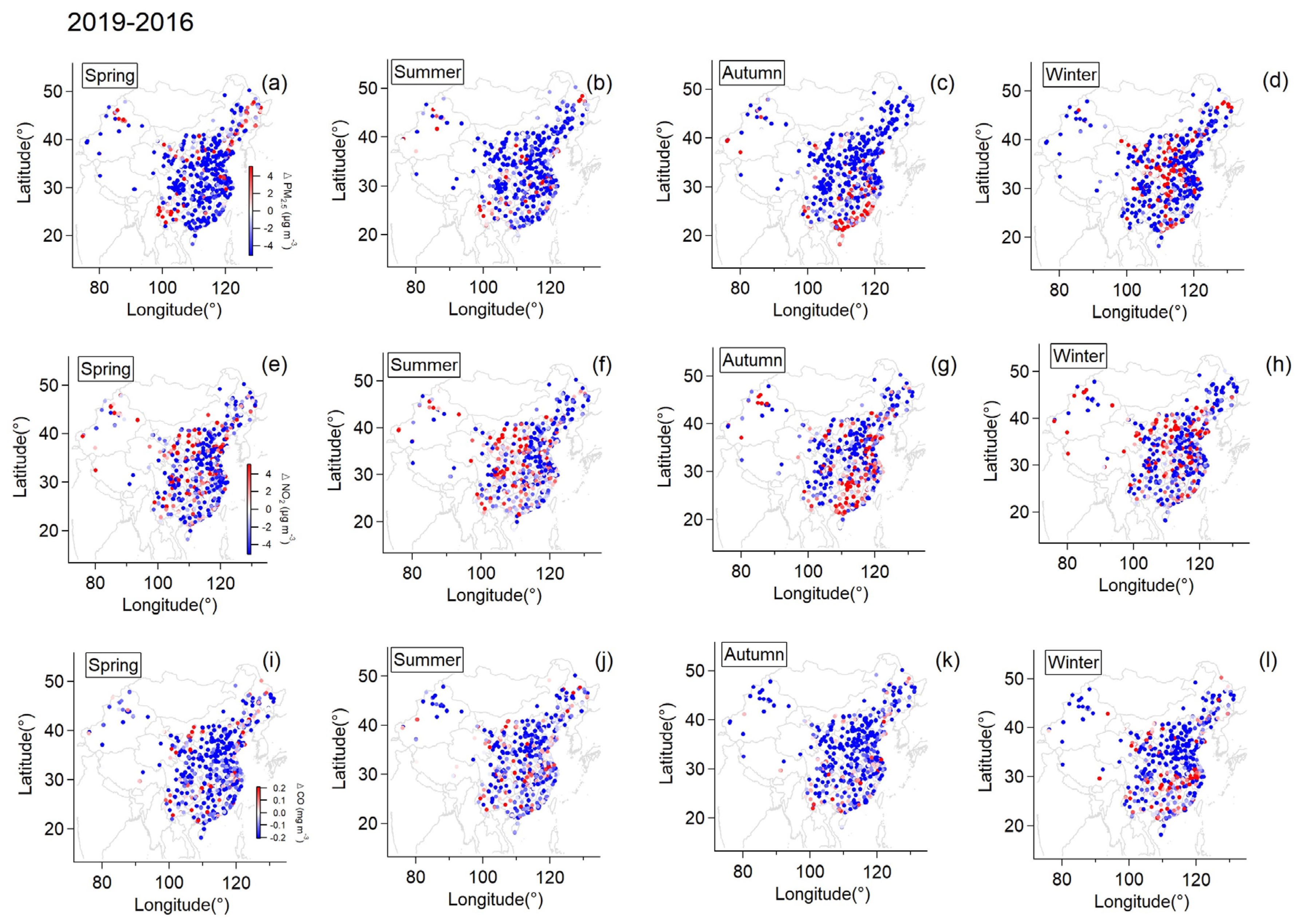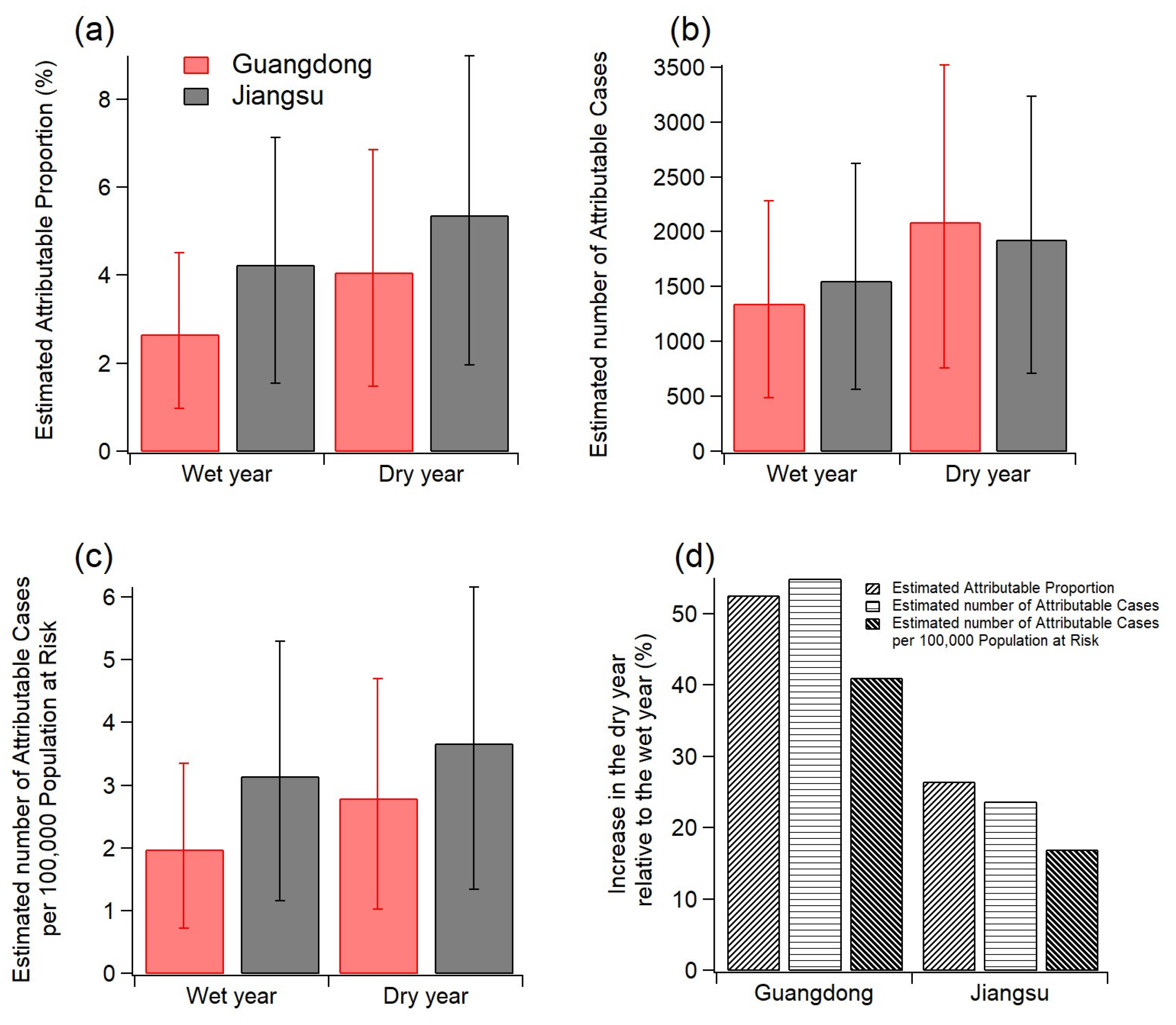Contrasting Near-Surface Ozone Pollution in Wet and Dry Year over China
Abstract
:1. Introduction
2. Materials and Methods
3. Results and Discussions
3.1. Meteorology Contrast between 2016 and 2019
3.2. The Aggravation of Surface Ozone in the Dry Year
3.3. The Health Outcomes of Ozone Aggravation: Case Studies
4. Conclusions
Supplementary Materials
Author Contributions
Funding
Institutional Review Board Statement
Informed Consent Statement
Data Availability Statement
Conflicts of Interest
References
- Monks, P.S.; Archibald, A.T.; Colette, A.; Cooper, O.; Coyle, M.; Derwent, R.; Fowler, D.; Granier, C.; Law, K.S.; Mills, G.E.; et al. Tropospheric ozone and its precursors from the urban to the global scale from air quality to short-lived climate forcer. Atmos. Chem. Phys. 2015, 15, 8889–8973. [Google Scholar] [CrossRef] [Green Version]
- Jerrett, M.; Burnett, R.T.; Pope, C.A., 3rd; Ito, K.; Thurston, G.; Krewski, D.; Shi, Y.; Calle, E.; Thun, M. Long-term ozone exposure and mortality. N. Engl. J. Med. 2009, 360, 1085–1095. [Google Scholar] [CrossRef] [PubMed] [Green Version]
- Guan, Y.; Xiao, Y.; Chu, C.; Zhang, N.; Yu, L. Trends and characteristics of ozone and nitrogen dioxide related health impacts in Chinese cities. Ecotoxicol. Environ. Saf. 2022, 241, 113808. [Google Scholar] [CrossRef] [PubMed]
- Malley, C.S.; Henze, D.K.; Kuylenstierna, J.C.; Vallack, H.W.; Davila, Y.; Anenberg, S.C.; Turner, M.C.; Ashmore, M.R. Updated global estimates of respiratory mortality in adults ≥30 years of age attributable to long-term ozone exposure. Environ. Health Perspect. 2017, 125, 087021. [Google Scholar] [CrossRef] [Green Version]
- Lu, X.; Hong, J.; Zhang, L.; Cooper, O.R.; Schultz, M.G.; Xu, X.; Wang, T.; Gao, M.; Zhao, Y.; Zhang, Y. Severe surface ozone pollution in china: A global perspective. Environ. Sci. Technol. Lett. 2018, 5, 487–494. [Google Scholar] [CrossRef]
- Lu, X.; Zhang, L.; Wang, X.; Gao, M.; Li, K.; Zhang, Y.; Yue, X.; Zhang, Y. Rapid increases in warm-season surface ozone and resulting health impact in China since 2013. Environ. Sci. Technol. Lett. 2020, 7, 240–247. [Google Scholar] [CrossRef]
- Qu, H.; Wang, Y.; Zhang, R.; Li, J. Extending ozone-precursor relationships in China from peak concentration to peak time. J. Geophys. Res. Atmos. 2020, 125, e2020JD033670. [Google Scholar] [CrossRef]
- Yin, Z.; Cao, B.; Wang, H. Dominant patterns of summer ozone pollution in eastern China and associated atmospheric circulations. Atmos. Chem. Phys. 2019, 19, 13933–13943. [Google Scholar] [CrossRef] [Green Version]
- Liu, Y.; Wang, T. Worsening urban ozone pollution in China from 2013 to 2017—Part 1: The complex and varying roles of meteorology. Atmos. Chem. Phys. 2020, 20, 6305–6321. [Google Scholar] [CrossRef]
- Jacob, D.J.; Winner, D.A. Effect of climate change on air quality. Atmos. Environ. 2009, 43, 51–63. [Google Scholar] [CrossRef]
- Jeong, J.I.; Park, R.J. Effects of the meteorological variability on regional air quality in East Asia. Atmos. Environ. 2013, 69, 46–55. [Google Scholar] [CrossRef]
- Kavassalis, S.C.; Murphy, J.G. Understanding ozone-meteorology correlations: A role for dry deposition. Geophys. Res. Lett. 2017, 44, 2922–2931. [Google Scholar] [CrossRef]
- Doherty, R.M.; Wild, O.; Shindell, D.T.; Zeng, G.; MacKenzie, I.A.; Collins, W.J.; Fiore, A.M.; Stevenson, D.S.; Dentener, F.J.; Schultz, M.G.; et al. Impacts of climate change on surface ozone and intercontinental ozone pollution: A multi-model study. J. Geophys. Res. Atmos. 2013, 118, 3744–3763. [Google Scholar] [CrossRef] [Green Version]
- Zhang, H.; Wang, Y.; Park, T.-W.; Deng, Y. Quantifying the relationship between extreme air pollution events and extreme weather events. Atmos. Res. 2017, 188, 64–79. [Google Scholar] [CrossRef]
- Xu, L.; Yu, J.-Y.; Schnell, J.L.; Prather, M.J. The seasonality and geographic dependence of ENSO impacts on U.S. surface ozone variability. Geophys. Res. Lett. 2017, 44, 3420–3428. [Google Scholar] [CrossRef] [Green Version]
- Yang, Y.; Li, M.; Wang, H.; Li, H.; Wang, P.; Li, K.; Gao, M.; Liao, H. ENSO modulation of summertime tropospheric ozone over China. Environ. Res. Lett. 2022, 17, 034020. [Google Scholar] [CrossRef]
- Annual Precipitation of China in 2016 Reaches Record High with Warmer Conditions [EB/OL]. Available online: http://www.cma.gov.cn/en2014/news/News/201612/t20161230_368360.html (accessed on 1 August 2022).
- Zhang, Y.; Ren, Y.; Ren, G.; Wang, G. Precipitation trends over mainland china from 1961–2016 after removal of measurement biases. J. Geophys. Res. Atmos. 2020, 125, e2019JD031728. [Google Scholar] [CrossRef]
- Xu, K.; Miao, H.-Y.; Liu, B.; Tam, C.Y.; Wang, W. Aggravation of record-breaking drought over the mid-to-lower reaches of the Yangtze River in the post-monsoon season of 2019 by anomalous Indo-Pacific oceanic conditions. Geophys. Res. Lett. 2020, 47, e2020GL090847. [Google Scholar] [CrossRef]
- Huo, L.; Guan, Z.; Jin, D.; Liu, X.; Wang, X.; Xia, Y. The interdecadal variations and causes of the relationship between autumn precipitation anomalies in eastern China and SSTA over the southeastern tropical Indian Ocean. Clim. Dyn. 2022, 1–13. [Google Scholar] [CrossRef]
- Chu, B.; Ma, Q.; Liu, J.; Ma, J.; Zhang, P.; Chen, T.; Feng, Q.; Wang, C.; Yang, N.; Ma, H.; et al. Air pollutant correlations in China: Secondary air pollutant responses to NOx and SO2 control. Environ. Sci. Technol. Lett. 2020, 7, 695–700. [Google Scholar] [CrossRef]
- Wu, H.; Tang, X.; Wang, Z.; Wu, L.; Lu, M.; Wei, L.; Zhu, J. Probabilistic automatic outlier detection for surface air quality measurements from the China national environmental monitoring network. Adv. Atmos. Sci. 2018, 35, 1522–1532. [Google Scholar] [CrossRef]
- Hersbach, H.; Bell, B.; Berrisford, P.; Hirahara, S.; Horányi, A.; Muñoz-Sabater, J.; Nicolas, J.; Peubey, C.; Radu, R.; Schepers, D.; et al. The ERA5 global reanalysis. Q. J. R. Meteorol. Soc. 2020, 146, 1999–2049. [Google Scholar] [CrossRef]
- WHO Regional Office for Europe ECFEaH. AirQ+: Software Tool for Health Risk Assessment of Air Pollution; WHO Regional Office for Europe: Bonn, Germany, 2019. [Google Scholar]
- World Health Organization. Health Risks of Air Pollution in Europe–HRAPIE Project: Recommendations for Concentration–Response Functions for Cost–Benefit Analysis of Particulate Matter, Ozone and Nitrogen Dioxide; WHO Regional Office for Europe: Copenhagen, Denmark, 2013. [Google Scholar]
- Miller, B.H.F.; Shafrir, A. Health Impact Assessment for the National Emissions Ceiling Directive (NECD)—Methodological Issues; Institute of Occupational Medicine (IOM): Edinburgh, UK, 2011. [Google Scholar]
- Li, C.; Tian, Q.; Yu, R.; Zhou, B.; Xia, J.; Burke, C.; Dong, B.; Tett, S.F.; Freychet, N.; Lott, F.; et al. Attribution of extreme precipitation in the lower reaches of the Yangtze River during May 2016. Environ. Res. Lett. 2018, 13, 014015. [Google Scholar] [CrossRef]
- Zhou, C.; Wang, K.; Qi, D. Attribution of the July 2016 extreme precipitation event over China’s Wuhang. Bull. Am. Meteorol. Soc. 2018, 99, S107–S112. [Google Scholar] [CrossRef]
- Kogelschatz, U.; Eliasson, B.; Hirth, M. Ozone generation from oxygen and air: Discharge physics and reaction mechanisms. Ozone Sci. Eng. 1988, 10, 367–377. [Google Scholar] [CrossRef]
- Bowman, F.M.; Pilinis, C.; Seinfeld, J.H. Ozone and aerosol productivity of reactive organics. Atmos. Environ. 1995, 29, 579–589. [Google Scholar] [CrossRef]
- Horton, D.E.; Diffenbaugh, N.S.H. Response of air stagnation frequency to anthropogenically enhanced radiative forcing. Environ. Res. Lett. 2012, 7, 044034. [Google Scholar] [CrossRef]
- Zhang, Y.J.; Lei, R.Y.; Cui, S.J.; Wang, H.L.; Chen, M.D.; Ge, X.L. Spatiotemporal trends and impact factors of PM2.5 and O3 pollution in major cities in China during 2015–2020. Chin. Sci. Bull. 2022, 67, 2029–2042. (In Chinese) [Google Scholar] [CrossRef]
- Shao, M.; Zhang, Y.; Zeng, L.; Tang, X.; Zhang, J.; Zhong, L.; Wang, B. Ground-level ozone in the Pearl River Delta and the roles of VOC and NOx in its production. J. Environ. Manag. 2009, 90, 512–518. [Google Scholar] [CrossRef]
- Jiang, F.; Guo, H.; Wang, T.J.; Cheng, H.R.; Wang, X.M.; Simpson, I.J.; Ding, A.J.; Saunders, S.M.; Lam, S.H.M.; Blake, D.R. An ozone episode in the Pearl River Delta: Field observation and model simulation. J. Geophys. Res. Atmos. 2010, 115, D22305. [Google Scholar] [CrossRef]
- Zhan, C.; Xie, M.; Liu, J.; Wang, T.; Xu, M.; Chen, B.; Li, S.; Zhuang, B.; Li, M. Surface ozone in the Yangtze River Delta, China: A synthesis of basic features, meteorological driving factors, and health impacts. J. Geophys. Res. Atmos. 2021, 126, e2020JD033600. [Google Scholar] [CrossRef]
- Xu, J.; Huang, X.; Wang, N.; Li, Y.; Ding, A. Understanding ozone pollution in the Yangtze River Delta of eastern China from the perspective of diurnal cycles. Sci. Total Environ. 2021, 752, 141928. [Google Scholar] [CrossRef] [PubMed]
- National Bureau of Statistics of China. China Health Statistics Yearbook 2016 and 2019; China Statistics Press: Beijing, China, 2016 and 2019.







Disclaimer/Publisher’s Note: The statements, opinions and data contained in all publications are solely those of the individual author(s) and contributor(s) and not of MDPI and/or the editor(s). MDPI and/or the editor(s) disclaim responsibility for any injury to people or property resulting from any ideas, methods, instructions or products referred to in the content. |
© 2023 by the authors. Licensee MDPI, Basel, Switzerland. This article is an open access article distributed under the terms and conditions of the Creative Commons Attribution (CC BY) license (https://creativecommons.org/licenses/by/4.0/).
Share and Cite
Ding, S.; Jiang, X.; Wu, C. Contrasting Near-Surface Ozone Pollution in Wet and Dry Year over China. Int. J. Environ. Res. Public Health 2023, 20, 998. https://doi.org/10.3390/ijerph20020998
Ding S, Jiang X, Wu C. Contrasting Near-Surface Ozone Pollution in Wet and Dry Year over China. International Journal of Environmental Research and Public Health. 2023; 20(2):998. https://doi.org/10.3390/ijerph20020998
Chicago/Turabian StyleDing, Shuo, Xiaotong Jiang, and Changhao Wu. 2023. "Contrasting Near-Surface Ozone Pollution in Wet and Dry Year over China" International Journal of Environmental Research and Public Health 20, no. 2: 998. https://doi.org/10.3390/ijerph20020998





